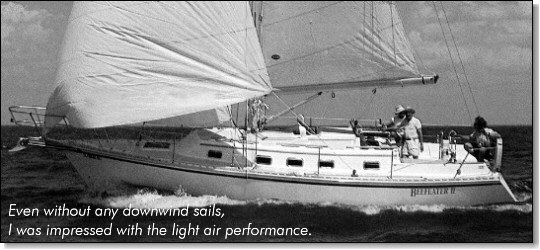
![]() eíve been building and designing sailboats since we were kids,"
explained George McCreary, one half of the successful brother team that
heads up Caliber Yacht Corp., based in Clearwater, Florida. "It just
seemed natural that we would form a company of our own one day."
eíve been building and designing sailboats since we were kids,"
explained George McCreary, one half of the successful brother team that
heads up Caliber Yacht Corp., based in Clearwater, Florida. "It just
seemed natural that we would form a company of our own one day."
While George runs the
business side of things, his brother Mike McCreary is a naval architect
who has designed the complete line of Caliberís ranging from their first
boat built in 1980, a now out-of-production 28-footer to a new 47-footer
due out this year.
I met George at the St. Petersburg Municipal Marina recently to take a
close look at the Caliber 35 and put her through her paces.
The 35 makes a good first
impression. While there is nothing radical or noticeably unique about
her design, she is clearly built to a high standard. From a varnished
bowsprit to stainless steel portlights to a sleek swim platform, the
Caliber 35 quietly blends tradition with
fresh thinking . With her
fin and skeg underbody, she defies easy classification and reminds me of
the days when there wasnít such a chasm between racing and cruising
boats.
I was impressed to see
that, unlike many of her competitors, the Caliber 35 does not rely on an
inner liner for structural strength. Instead, floor stringers are
laminated to the hull providing excellent load distribution for the
internally ballasted keel, support for the sub-sole and increased
overall hull rigidity. The bulkheads are laminated to the hull, adding
additional athwarthships integrity. Ideally, Iíd like to see
longitudinal stringers and solid fiberglass floor channels, but,
overall, Caliber is justifiably proud of their hull construction.
The deck is
through-bolted to the hull on a wide flange with an overlapping aluminum
toerail and PVC rubrail and bonded with generous amounts of #5200. The
deck is plywood cored, as opposed to end grain